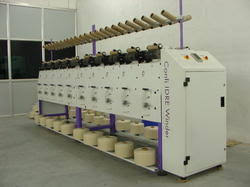Yarn
Yarn is a long continuous length of interlocked fibers, suitable for use in the production of textiles,sewing,crocheting,weaving,embroidery Or rope making . Thread is a type of yarn intended for sewing by hand or machine. Modern manufactured sewing threads may be finished with wax or other lubricants to withstand the stresses involved in sewing. embroidery threads are yarns specifically designed for needlework.
Fibers
The most common plant fiber is cotton, which is typically spun into fine yarn for mechanical weaving or knitting into cloth.
Cotton and polyester are the most commonly spun fibers in the world. Cotton is grown throughout the world. After harvesting it is ginned and prepared for yarn spinning. Polyester is extruded from polymers derived from natural gas and oil. Synthetic fibers are generally extruded in continuous strands of gel-state materials. These strands are drawn (stretched), annealed (hardened), and cured to obtain properties desirable for later processing.
Synthetic fibers come in three basic forms: staple, tow, and filament. Staple is cut fibers, generally sold in lengths up to 120mm. Tow is a continuous "rope" of fibers consisting of many filaments loosely joined side-to-side. Filament is a continuous strand consisting of anything from 1 filament to many. Synthetic fiber is most often measured in a weight per linear measurement basis, along with cut length. Denier and Dtex are the most common weight to length measures. Cut-length only applies to staple fiber.
Filament extrusion is sometimes referred to as "spinning" but most people equate spinning with spun yarn production.
The most commonly spun animal fiber is wool harvested from sheep. For hand knitting and hobby knitting, wool and acrylic yarns are frequently used.
Other animal fibers used include alpaca, angora, mohair, llama, cashmere, and silk. More rarely, yarn may be spun from camel, yak, musk ox, cat, dog, wolf, and rabbit hair, and even chinchilla as well as turkey feathers. Natural fibers such as these have the advantage of being slightly elastic and very breathable, while trapping a great deal of air, making for some of the warmest fabrics in existence.
Other natural fibers that can be used for yarn include linen and cotton. These tend to be much less elastic, and retain less warmth than the animal-hair yarns, though they can be stronger in some cases. The finished product will also look rather different from the woolen yarns. Other plant fibers which can be spun include bamboo, hemp, maize and soy fiber.
T-shirt yarn is a yarn made directly from t-shirts, and the fiber composition is determined by the material the t-shirt is made from.
Yarn Dying Calculation
Production Calculation of Yarn singeing machine: Length = Count * Weight = Count * Weight * 840 yards = (Count * Weight * 840) / rpm yards per minute = (Count * Weight * 840) / rpm * 60 * 8 * 3 yards per day = (Count * Weight * 840) / rpm * 60 * 8 * 3 * 0.914 =……X…meter/day.
=……X…meter/day.











0 Comments